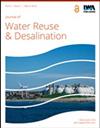Kinetics of diatrizoate degradation by ozone and the formation of disinfection by-products in the sequential chlorination
IF 2.3
Q2 Environmental Science
引用次数: 7
Abstract
In this study, we studied the degradation kinetics of a common iodine contrast agent, diatrizoate, by ozone and the formation of disinfection by-products (DBPs) in the sequential chlorination. Effects of ozone concentration, solution pH, and bromide concentration on diatrizoate degradation were evaluated. The results indicate that diatrizoate can be effectively degraded (over 80% within 1 h) by ozone, and the degradation kinetics can be well described using the pseudo-first-order kinetic model. The pseudo-first-order rate constant (kobs) of diatrizoate degradation significantly increased with increasing ozone concentration and decreasing bromide concentration. The kobs kept increasing with the increase of pH value and reached a maximum of 6.5 (±0.05) × 10−2 min−1 at pH 9. As the ozone concentration gradually increased from 0.342 to 1.316 mg/L, the corresponding kobs of diatrizoate degradation increased from 1.76 (±0.20) × 10−3 to 4.22 (±0.3) × 10−2 min−1. The bromide concentration exhibited a strong inhibitory effect on diatrizoate degradation because of the competition for ozone with diatrizoate. Trichloromethane was the only detected DBP in the subsequent chlorination in the absence of bromide. However, in the presence of bromide, six other DBPs were detected, and bromochloroiodomethane and tribromomethane became the major products with concentrations 1–2 orders higher than those of the other DBPs. In order to provide safe drinking water to the public, water should be maintained at circumneutral pH values and low bromine concentrations (<5 μM) before reaching the chlorine disinfection process to effectively control the formation of DBPs.臭氧降解非水杨酸盐的动力学及顺序氯化过程中消毒副产物的形成
在这项研究中,我们研究了臭氧对一种常见的碘造影剂,异位酸酯的降解动力学以及顺序氯化过程中消毒副产物(DBPs)的形成。考察了臭氧浓度、溶液pH值和溴化物浓度对脱盐的影响。结果表明,臭氧可有效地降解水中的三次位酸酯(1 h内可降解80%以上),降解动力学可以用拟一级动力学模型很好地描述。随着臭氧浓度的增加和溴化物浓度的降低,异位酸盐降解的准一级速率常数(kobs)显著增加。随着pH值的增加,kobs不断增加,在pH值为9时达到最大值6.5(±0.05)× 10−2 min−1。随着臭氧浓度从0.342 mg/L逐渐增加到1.316 mg/L,相应的异位藻降解kobs从1.76(±0.20)× 10−3增加到4.22(±0.3)× 10−2 min−1。溴化物浓度表现出较强的抑制作用,因为它与异质酸争夺臭氧。在没有溴化物的情况下,三氯甲烷是随后的氯化反应中唯一检测到的DBP。然而,在溴化物存在的情况下,检测到其他6种dbp,其中溴氯碘甲烷和三溴甲烷是主要产物,其浓度比其他dbp高1-2个数量级。为了向公众提供安全的饮用水,在进入氯消毒过程之前,应将水保持在环中性pH值和低溴浓度(<5 μM),以有效控制dbp的形成。
本文章由计算机程序翻译,如有差异,请以英文原文为准。
求助全文
约1分钟内获得全文
求助全文
来源期刊

Journal of Water Reuse and Desalination
ENGINEERING, ENVIRONMENTAL-WATER RESOURCES
CiteScore
4.30
自引率
0.00%
发文量
23
审稿时长
16 weeks
期刊介绍:
Journal of Water Reuse and Desalination publishes refereed review articles, theoretical and experimental research papers, new findings and issues of unplanned and planned reuse. The journal welcomes contributions from developing and developed countries.
 求助内容:
求助内容: 应助结果提醒方式:
应助结果提醒方式:


